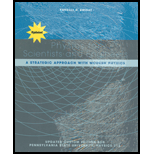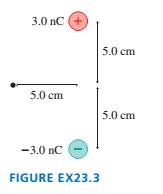
PHYS 212 FOR SCI+ENG W/MAST PHYS >ICP<
1st Edition
ISBN: 9781323834831
Author: Knight
Publisher: PEARSON C
expand_more
expand_more
format_list_bulleted
Concept explainers
Textbook Question
Chapter 23, Problem 3EAP
What are the strength and direction of the electric field at the position indicated by the dot in FIGURE EX23.3? Specify the direction as an angle above or below horizontal.

Expert Solution & Answer
Want to see the full answer?
Check out a sample textbook solution
Students have asked these similar questions
PLEASE help with the experimental setup for this theory because i am so confused.
Part 2 - Geometry and Trigonometry
1. Line B touches the circle at a single point. Line A extends radially through the center of
the circle.
A
B
(a) Which line is tangential to the circumference of the circle?
(b) What is the angle between lines A and B.
2. In the figure below what is the angle C?
30
45
3. In the figure below what is the value of the angle 0?
30°
4. In the figure below what is the value of the angle 0?
A
30°
Details solution
No chatgpt pls
Chapter 23 Solutions
PHYS 212 FOR SCI+ENG W/MAST PHYS >ICP<
Ch. 23 - l. You've been assigned the task of determining...Ch. 23 - Reproduce FIGURE Q23.2 on your paper. For each...Ch. 23 - Rank in order, from largest to smallest, the...Ch. 23 - A small segment of wire in FIGURE Q23.4 contains...Ch. 23 - An electron experiences a force of magnitude F...Ch. 23 - FIGURE Q23.6 shows a hollow soda straw that has...Ch. 23 - The irregularly shaped area of charge in FIGURE...Ch. 23 - A circular disk has surface charge density 8...Ch. 23 - A sphere of radius R has charge Q . The electric...Ch. 23 - The ball in FIGURE Q23.10 is suspended from a...
Ch. 23 - Rank in order, from largest to smallest, the...Ch. 23 - A parallel-plate capacitor consists of two square...Ch. 23 - A small object is released at point 3 in the...Ch. 23 - A proton and an electron are released from rest in...Ch. 23 - Three charges are placed at the comers of the...Ch. 23 - l. What are the strength and direction of the...Ch. 23 - What are the strength and direction of the...Ch. 23 - What are the strength and direction of the...Ch. 23 - What are the strength and direction of the...Ch. 23 - An electric dipole is formed from two charges, q ,...Ch. 23 - An electric dipole is formed from ± 1.0 nC charges...Ch. 23 - An electret is similar to a magnet, but rather...Ch. 23 - The electric field strength 10.0 cm from a very...Ch. 23 - A 10-cm-long thin glass rod uniformly charged to...Ch. 23 - Two 10-cm-long thin glass rods uniformly charged...Ch. 23 - A small glass bead charged to + 6.0 nC is in the...Ch. 23 - The electric field 5.0 cm from a very long charged...Ch. 23 - A 12-cm-long thin rod has the nonuniform charge...Ch. 23 - Two charged rings face each other, 20 cm apart....Ch. 23 - Two 10-cm-diameter charged rings face each other,...Ch. 23 - Two charged disks face each other, 20 cm apart....Ch. 23 - The electric field strength 2.0 cm from the...Ch. 23 - A 20cm20cm cm horizontal metal electrode is...Ch. 23 - Two 2.0-cm-diameter insulating spheres have a 6.0...Ch. 23 - You've hung two very large sheets of plastic...Ch. 23 - A 2.0m X 4.0m flat carpet acquires a uniformly...Ch. 23 - Two circular disks spaced 0.50 mm apart form a...Ch. 23 - A parallel-plate capacitor is formed from two...Ch. 23 - Air "breaks down" when the electric field strength...Ch. 23 - Two parallel plates 1.0 cm apart are equally and...Ch. 23 - a. What is the electric field strength between the...Ch. 23 - Honeybees acquire a charge while flying due to...Ch. 23 - An electron traveling parallel to a uniform...Ch. 23 - The surface charge density on an infinite charged...Ch. 23 - An electron in a vacuum chamber is fired with a...Ch. 23 - A 1.0m -diameter oil droplet (density 900 kg/m3)...Ch. 23 - The permanent electric dipole moment of the water...Ch. 23 - A point charge Q is distance r from a dipole...Ch. 23 - An ammonia molecule (NH3) has a permanent electric...Ch. 23 - What are the strength and direction of the...Ch. 23 - What are the strength and direction of the...Ch. 23 - What are the strength and direction of the...Ch. 23 - Prob. 38EAPCh. 23 - Prob. 39EAPCh. 23 - Derive Equation 23.11 for the field Edipolein the...Ch. 23 - FIGURE P23.41 is a cross section of two infinite...Ch. 23 - FIGURE P23.42 is a cross section of two infinite...Ch. 23 - Prob. 43EAPCh. 23 - Prob. 44EAPCh. 23 - Prob. 45EAPCh. 23 - Prob. 46EAPCh. 23 - Prob. 47EAPCh. 23 - A plastic rod with linear charge density ? is bent...Ch. 23 - An infinite plane of charge with surface charge...Ch. 23 - A sphere of radius R and surface charge density ?...Ch. 23 - Prob. 51EAPCh. 23 - An electron is launched at a 45 angle and a speed...Ch. 23 - The two parallel plates in FIGURE P23.53 are 2.0...Ch. 23 - Prob. 54EAPCh. 23 - Prob. 55EAPCh. 23 - 56. Your physics assignment is to figure out a way...Ch. 23 - Prob. 57EAPCh. 23 - Prob. 58EAPCh. 23 - Prob. 59EAPCh. 23 - Prob. 60EAPCh. 23 - Prob. 61EAPCh. 23 - Prob. 62EAPCh. 23 - In Problems 63 through 66 you are given the...Ch. 23 - Prob. 64EAPCh. 23 - Prob. 65EAPCh. 23 - Prob. 66EAPCh. 23 - A rod of length L lies along the y-axis with its...Ch. 23 - a. An infinitely long sheet of charge of width L...Ch. 23 - a. An infinitely long sheet of charge of width L...Ch. 23 - Prob. 70EAPCh. 23 - Prob. 71EAPCh. 23 - 72. A proton orbits a long charged wire, making ...Ch. 23 - Prob. 73EAP
Knowledge Booster
Learn more about
Need a deep-dive on the concept behind this application? Look no further. Learn more about this topic, physics and related others by exploring similar questions and additional content below.Similar questions
- Please solve and answer the problem correctly please.Thank you!!arrow_forwardWill you please walk me through the calculations in more detail for solving this problem? I am a bit rusty on calculus and confused about the specific steps of the derivation: https://www.bartleby.com/solution-answer/chapter-3-problem-15e-modern-physics-2nd-edition/9780805303087/7cf8c31d-9476-46d5-a5a9-b897b16fe6fcarrow_forwardplease help with the abstract. Abstract - This document outlines the format of the lab report and describes the Excel assignment. The abstract should be a short paragraph that very briefly includes the experiment objective, method, result and conclusion. After skimming the abstract, the reader should be able to decide whether they want to keep reading your work. Both the format of the report and the error analysis are to be followed. Note that abstract is not just the introduction and conclusion combined, but rather the whole experiment in short including the results. I have attacted the theory.arrow_forward
- Using the Experimental Acceleration due to Gravity values from each data table, Data Tables 1, 2, and 3; determine the Standard Deviation, σ, mean, μ, variance, σ2 and the 95% Margin of Error (Confidence Level) Data: Ex. Acc. 1: 12.29 m/s^2. Ex. Acc. 2: 10.86 m/s^2, Ex. Acc. 3: 9.05 m/s^2arrow_forwardIn the Super Smash Bros. games the character Yoshi’s has a “ground pound” down special move where he launches himself downward to attack an enemy beneath him. A) If Yoshi flings himself downwards at 9.76 miles per hour to hit an enemy 10.5 m below him, how fast is Yoshi traveling when he hits the enemy? 1 mile = 1609 m B) How much time does it take Yoshi to hit the enemy beneath him?arrow_forwardNo chatgpt pls will upvotearrow_forward
- 1.62 On a training flight, a Figure P1.62 student pilot flies from Lincoln, Nebraska, to Clarinda, Iowa, next to St. Joseph, Missouri, and then to Manhattan, Kansas (Fig. P1.62). The directions are shown relative to north: 0° is north, 90° is east, 180° is south, and 270° is west. Use the method of components to find (a) the distance she has to fly from Manhattan to get back to Lincoln, and (b) the direction (relative to north) she must fly to get there. Illustrate your solutions with a vector diagram. IOWA 147 km Lincoln 85° Clarinda 106 km 167° St. Joseph NEBRASKA Manhattan 166 km 235° S KANSAS MISSOURIarrow_forwardPlz no chatgpt pls will upvotearrow_forward3.19 • Win the Prize. In a carnival booth, you can win a stuffed gi- raffe if you toss a quarter into a small dish. The dish is on a shelf above the point where the quarter leaves your hand and is a horizontal dis- tance of 2.1 m from this point (Fig. E3.19). If you toss the coin with a velocity of 6.4 m/s at an angle of 60° above the horizontal, the coin will land in the dish. Ignore air resistance. (a) What is the height of the shelf above the point where the quarter leaves your hand? (b) What is the vertical component of the velocity of the quarter just before it lands in the dish? Figure E3.19 6.4 m/s 2.1arrow_forward
arrow_back_ios
SEE MORE QUESTIONS
arrow_forward_ios
Recommended textbooks for you
 Physics for Scientists and Engineers: Foundations...PhysicsISBN:9781133939146Author:Katz, Debora M.Publisher:Cengage Learning
Physics for Scientists and Engineers: Foundations...PhysicsISBN:9781133939146Author:Katz, Debora M.Publisher:Cengage Learning College PhysicsPhysicsISBN:9781938168000Author:Paul Peter Urone, Roger HinrichsPublisher:OpenStax College
College PhysicsPhysicsISBN:9781938168000Author:Paul Peter Urone, Roger HinrichsPublisher:OpenStax College
 Principles of Physics: A Calculus-Based TextPhysicsISBN:9781133104261Author:Raymond A. Serway, John W. JewettPublisher:Cengage Learning
Principles of Physics: A Calculus-Based TextPhysicsISBN:9781133104261Author:Raymond A. Serway, John W. JewettPublisher:Cengage Learning College PhysicsPhysicsISBN:9781305952300Author:Raymond A. Serway, Chris VuillePublisher:Cengage Learning
College PhysicsPhysicsISBN:9781305952300Author:Raymond A. Serway, Chris VuillePublisher:Cengage Learning Physics for Scientists and Engineers with Modern ...PhysicsISBN:9781337553292Author:Raymond A. Serway, John W. JewettPublisher:Cengage Learning
Physics for Scientists and Engineers with Modern ...PhysicsISBN:9781337553292Author:Raymond A. Serway, John W. JewettPublisher:Cengage Learning

Physics for Scientists and Engineers: Foundations...
Physics
ISBN:9781133939146
Author:Katz, Debora M.
Publisher:Cengage Learning

College Physics
Physics
ISBN:9781938168000
Author:Paul Peter Urone, Roger Hinrichs
Publisher:OpenStax College


Principles of Physics: A Calculus-Based Text
Physics
ISBN:9781133104261
Author:Raymond A. Serway, John W. Jewett
Publisher:Cengage Learning

College Physics
Physics
ISBN:9781305952300
Author:Raymond A. Serway, Chris Vuille
Publisher:Cengage Learning

Physics for Scientists and Engineers with Modern ...
Physics
ISBN:9781337553292
Author:Raymond A. Serway, John W. Jewett
Publisher:Cengage Learning
Electric Fields: Crash Course Physics #26; Author: CrashCourse;https://www.youtube.com/watch?v=mdulzEfQXDE;License: Standard YouTube License, CC-BY